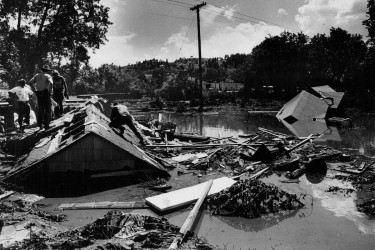American citizens often struggle to understand what Native people value, especially with respect to reservation land protected by treaties signed with the U.S. government. Indians and non-Indians came to share a sense of environmental crisis during the late 1960s and early 1970s. They all recognized a crisis of polluted air and water, littered landscapes, a loss of open space, and pesticides in foodstuffs. The crisis was documented in books with apocalyptic titles such as The Last Landscape and America the Raped, as well as in an influential 1967 essay published in the prestigious journal Science, “The Historical Roots of Our Ecologic Crisis.” Television reports depicted oil spills and burning rivers and views of the earth from the moon landing in 1969 made visible the scope of the damage.
In April 1971 the Keep America Beautiful organization released the iconic “Crying Indian” public service announcement. The announcement appeared on billboards and in a television segment showing an American Indian figure paddling through industrial refuse and standing amongst roadside litter, a single tear on his cheek. The image helped cement the notion that American Indians were different, that they cared about using natural resources wisely and thus could model the behavior American society needed to ameliorate its environmental crisis.
But the Crying Indian image elided the ways in which Native Americans had tried to characterize their campaigns as a different kind of progress: not to resist particular modes and models of industrial development to sustain a “traditional” lifestyle on unchanging reservations but rather to articulate the boundaries of a reservation protected by treaty. They employed scientific conservation programs and asserted the special relationship they had with spaces they needed for their religious ceremonies. American Indians did not act as symbols like the Crying Indian but rather as allies in a larger struggle to protect land, air, and water from pollution that didn’t stop at the edge of the reservation.
In 1966 the National Congress of American Indians (NCAI), the largest pan-Indian organization in the U.S., wrote an editorial to condemn unrestrained growth: “Today we have the senseless cry of ‘Development.’ Soon the country will be completely asphaltized, parking spaces will abound where forests grew, life will indeed be pre-fabricated.” The editorial posed the central question for both Indian and non-Indian environmental critiques of the postwar period: “Are [Indians] then against progress? It seems to be a dangerous thing to be against progress as if progress had some divine attribute that places it above suspicion. People progress, but they progress by incorporating the best of their traditions with novel approaches to their social problems within their own social structures.”












